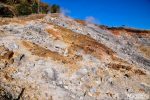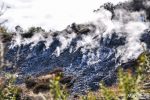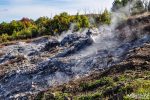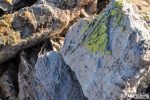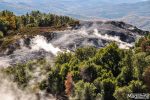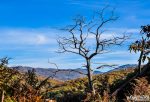Dante found inspiration in this foul-smelling, sulphur-coloured, steaming landscape for his “Hell” in the Divine Comedy. I find it more extraterrestrial in appearance, as if Mars and the Moon had a lovechild. The lunar-like surface is full of fumaroles from which steam is hissing or water is boiling. Le Biancane Nature Park is a unique geological experience. And it’s for free!
The park is one of the most overlooked and underestimated attractions in Tuscany. By all means, Tuscany is full of world-class sights, but this park and the geothermal activities are truly unique. I have never seen anything like this on my travels in Europe.
The crystallizations of the calcareous deposits together with sulphur and iron gives the park a striking colour effect. The fumaroles – the openings in the planet’s crust, which emits steam and gases – are manifold and it’s like walking around in a fairytale. Or Dante’s nightmarish depictions of Hell. I guess it depends on the weather – and your state of mind!
Lunar-like landscape
As soon as you park your car, you notice the sulphur smell in the air. It gets worse as you approach the steaming hills of Le Biancane Nature Park. At times, the odors are so overwhelming, you just need to hold your breath.
As you move around the park, you start noticing your feet getting (or staying) nice and warm. That’s simply because the ground is warm to touch, meaning our trek through the landscape on a 15-degree-celsius-Saturday in November ended in t-shirt and shorts.
Century old applications
Even the Etruscans and the Romans used the local hot waters for thermal baths and extracted the boric salts, that settled on the borders of the ponds, for pharmaceutical purposes.
As time progressed, so did the understanding of the minerals and their use. In the Middle ages, sulphur was distilled and used for bleaching textiles, vitriol was used together with tannin to dye textiles black and alum was used to fixate colour and for tanning leather and hides.
Clean energy
Nowadays, the geothermal capacity is being used to produce energy. A lot of energy. Enel Green Power runs 33 geothermal power plants in Tuscany, that can deliver a total output of about 761 MW, providing an annual production of over 5 billion kWh, which is able meet more than 22% of the regional consumption.
The hot gas from the fumaroles is harvested into the power plants, where it’s used to drive generators. After it’s cooled off (that’s the steam you see evaporating from the large cooling towers, that are often associated with nuclear plants) the liquid, mainly water, is pumped back into the ground where it will sink down until it becomes hot enough to once more evaporate as hot gas. It’s green, it’s clean, it’s a perpetual motion machine.
After you’ve hiked around the park and seen the Enel power plants, we recommend driving to Larderello, where the Geothermal Energy Museum will explain both the history about geothermal utilisation and the technicalities in running a geothermal power plant. And it’s free too!
Treks for all
You can walk around Le Biancane Nature Park without a map. There are several signs and the pathways are clearly marked. At some steep climbs, there are even steps and rope to help you navigate the somewhat wild landscape. You can easily cover the park on either a 2 or 5 kilometre round trip, depending on your form. There are many informational signboards, where you can learn about the history of the area, the application of geothermics and the vegetation in the zone.
We recommend starting off from Lagoni del Sasso, walking south to the fumaroles near Lagoni and then back again. It’s a 4,5 kilometre walk, that will take you past some of the most stunning geothermal landscapes south of Iceland.
If you’re thirsty after all this hearty walking and hot fumes, don’t despair: you’re in the vicinity of some of Italy’s best wine country. Check out our insight on Wine Touring in Tuscany – Montalcino.
More info
- Biancane Park on Monterotondo Marittimo website
- Le Biancane Nature Park on Visit Tuscany website
- Larderello Geothermal Energy Museum
Learn more










